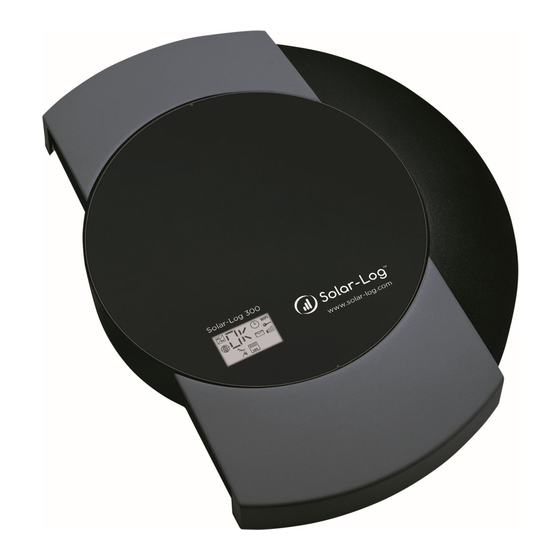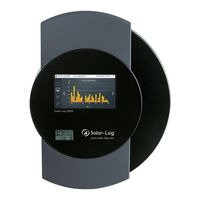
Solar-Log 250 PV Plant Monitoring Manuals
Manuals and User Guides for Solar-Log 250 PV Plant Monitoring. We have 4 Solar-Log 250 PV Plant Monitoring manuals available for free PDF download: Manual, Installation Manual, Connection Manual
Solar-Log 250 Manual (319 pages)
Brand: Solar-Log
|
Category: Measuring Instruments
|
Size: 17 MB
Table of Contents
-
-
Introduction10
-
S0-In B35
-
Usb65
-
Installation66
-
Main Menu85
-
VLCD Display85
-
Ethernet87
-
Proxy95
-
Access Type96
-
Portal96
-
E-Mail99
-
Export101
-
Backup101
-
Device Detection108
-
General118
-
Plant Groups119
-
Graphic119
-
Recipient124
-
Yield127
-
Power & Failure132
-
Smart Energy139
-
Plant Parameters154
-
Active Power156
-
Lar-Log™ PM+)160
-
Reactive Power164
-
Profile173
-
Direct Marketing175
-
Editing Data176
-
Initial Yield176
-
Data Correction177
-
System Backup177
-
Backup179
-
Reset181
-
Access Control183
-
Display186
-
Licenses187
-
Firmware187
-
Inverter Details191
-
Balances197
-
Fig.: Event Log199
-
PM History209
-
Fig.: PM History209
-
Smart Energy214
-
History Section216
-
Fig.: CSV Export220
-
Current Values222
-
Energy Flow224
-
Table225
-
Production226
-
Day View227
-
Month View229
-
Year View231
-
Total View232
-
Balances239
-
Day Balance241
-
Month Balance242
-
Year Balance243
-
Total Balance244
-
Finances245
-
USB Menu266
-
Fault Messages278
-
Normal Operation279
-
Power Reduction279
-
Faults280
-
Reset Buttons280
-
Reset280
-
Fault Messages283
-
Special Cases291
-
Cleaning Tips292
-
Care Tips292
-
Disposal293
-
Technical Data294
-
Appendix298
-
Internet Ports298
-
Modbus TCP311
-
Dimensions315
-
Advertisement
Solar-Log 250 Manual (303 pages)
Brand: Solar-Log
|
Category: Control Panel
|
Size: 5 MB
Table of Contents
-
-
Introduction10
-
S0-In B29
-
Usb58
-
14 Main Menu79
-
VLCD Display79
-
Ethernet84
-
Proxy86
-
Access Type87
-
Portal87
-
E-Mail89
-
Export91
-
Backup91
-
General105
-
Plant Groups105
-
Graphic106
-
Recipient109
-
Yield Mail112
-
Power & Failure117
-
Smart Energy125
-
Plant Parameters141
-
Active Power143
-
Reactive Power151
-
Meter)155
-
Profile161
-
Direct Marketing162
-
Editing Data163
-
Initial Yield163
-
Data Correction164
-
System Backup164
-
Backup166
-
Reset168
-
Access Control170
-
Display173
-
Licenses174
-
Firmware175
-
Inverter Details179
-
Balances185
-
Fig.: Event Log187
-
Feed-Balance197
-
Fig.: PM History198
-
PM History198
-
Smart Energy201
-
History Section204
-
Fig.: CSV Export208
-
Current Values211
-
Energy Flow213
-
Table214
-
Production215
-
Day View216
-
Month View218
-
Year View220
-
Total View221
-
Balances228
-
Day Balance230
-
Month Balance231
-
Year Balance232
-
Total Balance233
-
Finances234
-
USB Menu253
-
Fault Messages263
-
Normal Operation264
-
Power Reduction265
-
21 Faults266
-
Reset Buttons266
-
Reset266
-
Fault Messages269
-
Special Cases275
-
Cleaning Tips276
-
Care Tips276
-
23 Disposal277
-
25 Appendix282
-
Internet Ports282
-
Modbus TCP295
-
Dimensions299
-
Solar-Log 250 Installation Manual (224 pages)
Table of Contents
-
-
S0-In34
-
Usb64
-
Installation65
-
Main Menu73
-
Ethernet75
-
Proxy82
-
Portal83
-
Access Type83
-
E-Mail84
-
Export86
-
Backup86
-
Module Fields101
-
Battery102
-
General103
-
Plant Groups104
-
Graphic104
-
Recipient109
-
Yield112
-
Power & Failure113
-
Initial Yield116
-
Editing Data116
-
Data Correction117
-
System Backup117
-
Backup119
-
Reset121
-
Access Control123
-
Display126
-
Licenses127
-
Firmware127
-
Smart Energy130
-
Plant Parameters143
-
Active Power145
-
Log™ PM+)149
-
Reactive Power153
-
Profile162
-
Direct Marketing164
-
USB Menu175
-
Fault Messages185
-
Normal Operation186
-
Power Reduction186
-
Reset187
-
Reset Buttons187
-
Faults187
-
Fault Messages190
-
Special Cases198
-
Disposal199
-
Technical Data200
-
Internet Ports204
-
Appendix204
-
Modbus TCP217
-
JSON Interfaces219
-
Dimensions221
Advertisement
Solar-Log 250 Connection Manual (24 pages)
Brand: Solar-Log
|
Category: Measuring Instruments
|
Size: 0 MB
Table of Contents
-
-
Inepro12
-
-
-
Inepro 75D14
-
Iskra16
-



